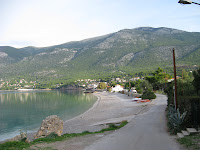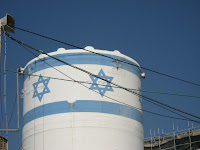 After leaving the Necromanteion, we traveled up the mountain to Delphi, where the famous Delphic Oracle gave guidance to rich and poor alike, who came from throughout the Greek world. From the 14th century BC until its height of popularity in the 4th century BC, Delphi, was the most important religious center within the Greek Empire.
After leaving the Necromanteion, we traveled up the mountain to Delphi, where the famous Delphic Oracle gave guidance to rich and poor alike, who came from throughout the Greek world. From the 14th century BC until its height of popularity in the 4th century BC, Delphi, was the most important religious center within the Greek Empire. We returned to Athens with a day to explore the ancient ruins in the middle of this modern city. We saw the Acropolis, Theatre of Dionysos, and the Temple of Zeus.
We returned to Athens with a day to explore the ancient ruins in the middle of this modern city. We saw the Acropolis, Theatre of Dionysos, and the Temple of Zeus. The Wisdom University class left and I stayed with my friend for the next two weeks in the foothills above the city and overlooking the Saronic Gulf below.
 For the most part, we lived in her apartment and went about the day-to-day activities of the local Greek residents--shopping in the farmers markets, getting goat cheese and yogurt from the little shop on the corner, having Sunday meals in family's favorite fish restaurant and hanging our wash out on the balcony of the house to dry in the sun.
For the most part, we lived in her apartment and went about the day-to-day activities of the local Greek residents--shopping in the farmers markets, getting goat cheese and yogurt from the little shop on the corner, having Sunday meals in family's favorite fish restaurant and hanging our wash out on the balcony of the house to dry in the sun.
 One day, we traveled by bus to the place where my friend's father's family went for summers when it was hot in Athens. It was a lovely coastal village over the mountains. There we explored the place where she was baptized as a baby--which happened to be in a little Greek Orthodox Church of "Ayios Georgios" (St. George).
One day, we traveled by bus to the place where my friend's father's family went for summers when it was hot in Athens. It was a lovely coastal village over the mountains. There we explored the place where she was baptized as a baby--which happened to be in a little Greek Orthodox Church of "Ayios Georgios" (St. George). We went into this little chapel and my friend lit a candle, and we prayed our Peace Prayers, remembering the people here who defended their coastline from the invaders from the "Fortress of Aigosthena" which was located just above the church. Then we went down into the village and had a nice meal in the only restaurant still open, now that the tourists had left for the season.
We returned to Athens and resumed our normal schedule of early morning yoga, meditation, and Peace Prayers. It was there in her garden, that I planted our 5th Crystal along with the flower seeds scheduled to come up and bloom this spring.
Be a breath of life unto the body of humankind,
a dew upon the soil of the human heart,
and a fruit upon the tree of humility.












































